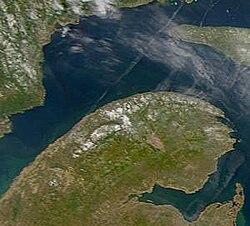Gaspé Peninsula: Difference between revisions
Added a parameter to template:Cite Americana and other fixes using AWB |
added En. equiv. |
||
| Line 6: | Line 6: | ||
[[File:Gaspésie unofficial flag.svg|thumb|right|250px|Unofficial Gaspésie flag.]] |
[[File:Gaspésie unofficial flag.svg|thumb|right|250px|Unofficial Gaspésie flag.]] |
||
The '''''Gaspésie''''' (official name), or '''Gaspé Peninsula''' |
The '''''Gaspésie''''' (official name), or '''Gaspé Peninsula''', '''the Gaspé''' or '''Gaspesia''', is a [[peninsula]] along the south shore of the [[Saint Lawrence River]] in [[Quebec]], [[Canada]], extending into the [[Gulf of Saint Lawrence]]. It is separated from [[New Brunswick]] on its southern side by the [[baie des Chaleurs|Baie des Chaleurs (Chaleur Bay)]] and the [[Restigouche River]]. |
||
The name "Gaspé" may come from a [[Mi'kmaq language|Mi'kmaq]] word ''gespeg'' meaning "land's end".{{citation needed|date=September 2011}} However, "Gaspé" may instead be a mutation of the Basque word "Gerizpe", meaning "shelter".<ref>According to Quebec's ''Commission de toponymie''</ref> |
The name "Gaspé" may come from a [[Mi'kmaq language|Mi'kmaq]] word ''gespeg'' meaning "land's end".{{citation needed|date=September 2011}} However, "Gaspé" may instead be a mutation of the Basque word "Gerizpe", meaning "shelter".<ref>According to Quebec's ''Commission de toponymie''</ref> |
||
Revision as of 10:50, 6 September 2012
You can help expand this article with text translated from the corresponding article in French. (June 2010) Click [show] for important translation instructions.
|



The Gaspésie (official name), or Gaspé Peninsula, the Gaspé or Gaspesia, is a peninsula along the south shore of the Saint Lawrence River in Quebec, Canada, extending into the Gulf of Saint Lawrence. It is separated from New Brunswick on its southern side by the Baie des Chaleurs (Chaleur Bay) and the Restigouche River.
The name "Gaspé" may come from a Mi'kmaq word gespeg meaning "land's end".[citation needed] However, "Gaspé" may instead be a mutation of the Basque word "Gerizpe", meaning "shelter".[1]
The area of the Gaspé Peninsula is near that of Belgium, at 30,341 square kilometres (11,715 sq mi). The population is approximately 100,000.
Landscape
Sea cliffs dominatate the peninsula's northern shore along the St. Lawrence River.[2] Cap Gaspé, jutting into the Gulf of St. Lawrence, is the easternmost point of the peninsula. Percé Rock (or rocher Percé), an island pierced by a natural arch, is located just offshore of the peninsula's eastern end. The peninsula's interior is rugged, being a northward continuation of the Appalachian Mountains called the Chic-Chocks, with Mont Jacques-Cartier at 1,268 metres (4,160 ft) the peninisula's highest peak.
Mount Albert (Mont Albert) at 1,151 m (3,776 ft)[3] is another high mountain in the Chic-Chocks. Its summit, an alpine area above the tree line, is a nearly flat plateau about 13 km (8 mi) across composed of serpentine bedrock and supporting a quite unusual flora.[4] The ascent of Mount Albert from near sea level is challenging, but popular with hikers, offering a view of the St. Lawrence and the Côte-Nord, the river's north shore, part of the ancient bedrock of the Canadian Shield.
Inland
The interior portions of the peninsula are dominated by the Chic-Choc Mountains, part of the Notre Dame Mountains, an extension of the Appalachian Mountains.
The town of Murdochville, at about 660 metres (2,170 ft) above sea level, has had a varied history, and is now home to several wind turbine farms which together have one of the largest wind-generating capacities in the world.[citation needed] It is reached by Route 198, which extends inland from the northern shore of the peninsula, soon climbing into the mountains and entering vast forests, crossing several small rivers before reaching the town. From Murdochville, Route 198 follows the York River to the city of Gaspé on the peninsula's eastern tip.
Economy
The economy of the peninsula has historically been focused on fishing, agriculture and forestry. However, primary resource based industries are suffering due to overfishing, overexploitation and fewer numbers of farmers in business, forcing the region to move towards tourism and the services industry.
Tourism
The peninsula is one of Quebec's most popular tourism regions. Route 132 circles the peninsula, with one branch following the coast and the other cutting across it at Sainte-Flavie, and a section of the International Appalachian Trail travels through the peninsula's mountains. The Gaspé National Park (Parc national de la Gaspésie) is located in the Chic-Chocs, and Forillon National Park is at the peninsula's northeastern tip.
See also
References
- ^ According to Quebec's Commission de toponymie
- ^ Fernald, M.L. (1932). "Botanizing on the Gaspé sea-cliffs". Harvard Alumni Bulletin. 36: 1–7.
- ^ Gouvernement du Québec (2011). "Mont Albert" (in French). Commission de toponymie. Retrieved 4 Jan. 2011.
{{cite web}}: Check date values in:|accessdate=(help) - ^ Scoggan, H.J. (1950). The Flora of Bic and the Gaspé Peninsula, Quebec. Ottawa, Canada: National Museum of Canada. p. 399.
